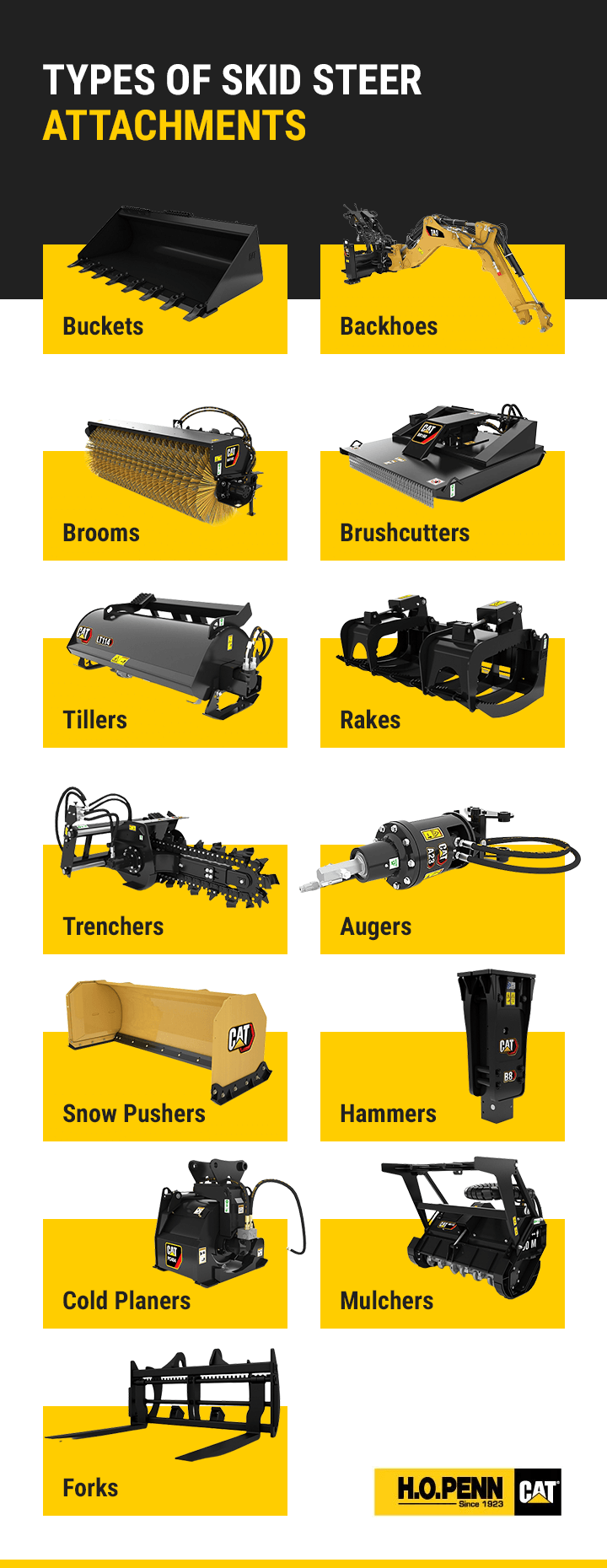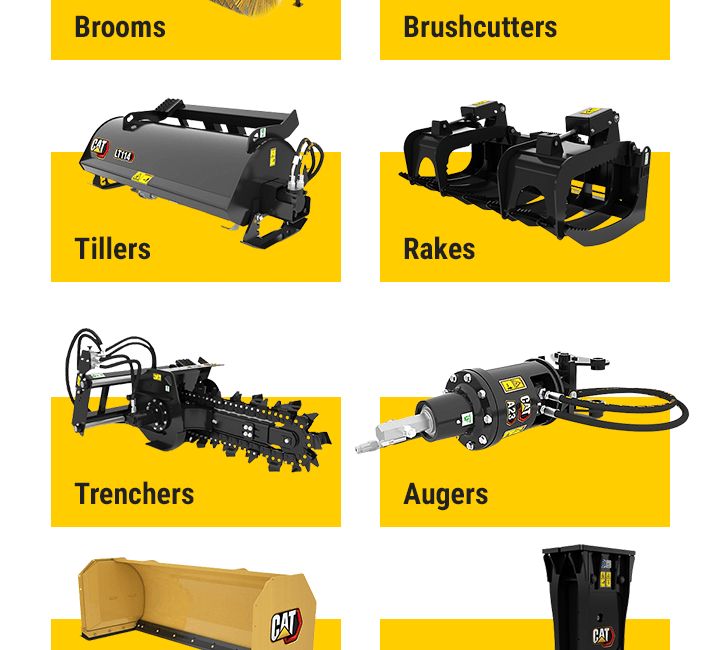Looking to find out all you need to know about skid steer attachments? Well, you’ve come to the right place! Skid steer attachments are like the secret superpowers that turn these already versatile machines into real workhorses. But hey, what’s the skinny on skid steer attachments exactly? Stick around as we dive into the world of these amazing add-ons and uncover their benefits, types, and popular uses.
Whether you’re a construction enthusiast, a homeowner with landscaping dreams, or just someone curious about heavy machinery, skid steer attachments have something exciting to offer. From buckets and forks to sweepers and grapples, these attachments can handle a wide range of tasks. So let’s get ready to explore the fascinating world of skid steer attachments and uncover the secrets to boosting their productivity!
Join us as we embark on a journey to understand how skid steer attachments can revolutionize the way you work and help you tackle various projects with ease. Ready to dive in? Let’s go!

What’s the Skinny on Skid Steer Attachments?
Skid steer attachments are a game-changer in the construction and landscaping industries. These versatile tools are designed to be easily mounted to skid steers, providing added functionality and efficiency to projects of all sizes. Whether you’re digging, lifting, pushing, or cutting, skid steer attachments offer the flexibility to tackle a wide range of tasks. In this article, we’ll dive into the world of skid steer attachments, exploring their types, benefits, and tips for maximizing their use.
The Different Types of Skid Steer Attachments
Skid steer attachments come in a variety of types, each designed for specific tasks. Let’s take a closer look at some of the most common ones:
Digging Attachments
Digging attachments, such as augers and trenchers, are perfect for excavation work. Augers can be used to drill holes for posts, trees, or fences, while trenchers make quick work of digging trenches for utilities or irrigation systems.
Another popular option is the grapple bucket, which is ideal for clearing debris, transporting materials, and loading/unloading materials from trucks or trailers. Grapple buckets can be equipped with either solid or flexible tines, depending on the specific job requirements.
When it comes to landscaping, skid steer attachments like rotary cutters and landscape rakes are invaluable. Rotary cutters are designed to clear thick brush and small trees, while landscape rakes help with leveling and grading tasks.
Lifting Attachments
Lifting attachments, such as pallet forks and material buckets, are essential for construction and warehouse projects. Pallet forks allow for the safe and efficient transportation and stacking of heavy pallets, while material buckets are perfect for moving loose materials like gravel or sand.
For more specialized lifting tasks, you can opt for attachments like the hydraulic boom. This attachment allows for precise lifting and positioning of heavy objects, making it useful in construction sites and manufacturing plants.
Another popular lifting attachment is the snow plow, which is a must-have during winter months. Whether you’re clearing snow from parking lots or residential driveways, the snow plow attachment will make the job much easier and faster.
Demolition Attachments
When it comes to demolitions, skid steer attachments like hydraulic breakers and concrete crushers are indispensable. Hydraulic breakers can easily break up concrete, asphalt, and other tough materials, while concrete crushers are used to crush and dispose of demolished concrete structures.
For smaller demolition jobs, such as removing tiles or breaking up small areas of concrete, you can utilize attachments like the jackhammer and demolition grapple. These attachments offer precision and versatility to tackle various demolition tasks.
Additionally, attachments like stump grinders and tree shears are perfect for land clearing projects. Stump grinders make quick work of removing unwanted tree stumps, while tree shears can safely cut and remove small trees.
Benefits of Using Skid Steer Attachments
Using skid steer attachments offers several benefits over traditional manual labor or dedicated heavy equipment. Let’s explore some of the key advantages:
- Increased Efficiency: Skid steer attachments allow for quicker completion of tasks, reducing labor costs and project timelines.
- Cost Savings: Instead of investing in multiple dedicated machines, skid steer attachments can be easily switched out, saving money on equipment costs.
- Versatility: With a wide range of attachments available, skid steers become adaptable to various jobs, eliminating the need for multiple machines on a project site.
- Compact Size: Skid steers are known for their maneuverability and small footprint, making them suitable for tight spaces and confined job sites.
- Operator Safety: Skid steer attachments enable operators to perform tasks from the comfort and safety of the skid steer cabin, reducing the risk of injuries.
Tips for Maximizing the Use of Skid Steer Attachments
To get the most out of skid steer attachments, consider these helpful tips:
- Choose the Right Attachment: Assess the specific requirements of your project and select the attachment that best suits the task at hand.
- Proper Maintenance: Regularly inspect and maintain your skid steer attachments for optimal performance and longevity.
- Operator Training: Ensure that operators are properly trained in the safe and efficient use of the attachments to avoid accidents and maximize productivity.
- Follow Manufacturer Guidelines: Adhere to the manufacturer’s recommendations for attachment usage, including weight limits and proper operating techniques.
- Monitor Attachment Wear: Keep an eye on the wear and tear of your attachments and replace any worn-out parts promptly to avoid performance issues.
Additional Considerations for Skid Steer Attachments
When using skid steer attachments, it’s important to consider a few additional factors:
Compatibility
Ensure that the attachment you choose is compatible with your skid steer model. Check the specifications and consult with the manufacturer or a professional to confirm compatibility.
Weight Capacity
Each skid steer has a specific weight capacity. It’s essential to know the maximum weight the skid steer can safely handle, including the attachment and any materials being lifted or handled.
Ground Conditions
Consider the terrain and ground conditions of your project site. Different attachments are better suited for different surfaces like rocky soil, soft mud, or pavement.
Storage and Transportation
When not in use, store your skid steer attachments in a clean and secure area to protect them from damage or theft. Ensure you have the proper means to transport the attachments to and from job sites safely.
Conclusion:
Skid steer attachments are a valuable addition to any construction or landscaping project, offering versatility, efficiency, and cost savings. By understanding the different types of attachments available and following best practices for their use, you can maximize the benefits they provide. Remember to prioritize safety and maintenance to ensure smooth operations and to extend the lifespan of your attachments. With the right attachments and proper care, your skid steer will become a powerhouse of productivity.
Key Takeaways: What You Need to Know About Skid Steer Attachments
- Skid steer attachments are tools and accessories specifically designed to be used with skid steer loaders.
- They can greatly enhance the versatility and functionality of skid steer loaders, allowing them to perform various tasks like digging, lifting, pushing, and more.
- There are a wide range of skid steer attachments available, including buckets, forks, grapples, augers, and brush cutters, each serving a specific purpose.
- When choosing skid steer attachments, it’s important to consider factors such as compatibility with the loader, application requirements, and budget.
- Skid steer attachments can be easily and quickly interchanged, making it convenient to switch between different tasks and maximize productivity.
Frequently Asked Questions
Welcome to our FAQ section on skid steer attachments! Here, we’ll answer some common questions you may have about this versatile equipment. Read on to learn more about the skinny on skid steer attachments!
1. What are skid steer attachments used for?
Skid steer attachments are used to enhance the capabilities of skid steer loaders, which are compact, versatile machines commonly used in construction, landscaping, agriculture, and many other industries. These attachments are designed to perform a wide range of tasks, such as excavating, grading, loading, lifting, and even snow removal. With the right attachment, a skid steer loader can take on various jobs, reducing the need for multiple specialized machines.
Whether you need to dig trenches, clear debris, move pallets, or spread material, skid steer attachments provide the flexibility to tackle different projects efficiently. From buckets and grapples to trenchers and brush cutters, there’s an attachment for almost any job you can imagine.
2. Can skid steer attachments be used with any skid steer loader?
Most skid steer attachments are designed to be compatible with different skid steer models and brands. However, it’s essential to ensure that the attachment you choose is suitable for your specific skid steer. Check the specifications and compatibility requirements provided by the manufacturer to ensure a proper fit.
Keep in mind that skid steer loaders come in different sizes and have varying lift capacities. It’s crucial to consider the weight and lifting capabilities of your skid steer loader when selecting attachments. Using attachments that exceed the loader’s specifications can lead to safety hazards and may cause damage to the equipment.
3. How do I attach skid steer attachments?
Attaching skid steer attachments is typically a straightforward process. Most attachments come with a universal mounting system, such as the standard skid steer quick attach system, which allows for easy and secure attachment to the skid steer loader. Here’s a general step-by-step guide:
1. Park the skid steer loader on a level surface and engage the parking brake.
2. Position the attachment in front of the loader’s coupler plate, aligning the attachment’s mounting plate with the loader’s quick attach plate.
3. Engage the attachment pins into the quick attach plate and secure them with locking pins or latches.
4. Double-check that the attachment is securely attached before operating the skid steer loader with the attachment.
4. Can skid steer attachments be operated by anyone?
Skid steer attachments should always be operated by trained individuals who are familiar with the particular attachment and understand the safety guidelines. While skid steer loaders are generally user-friendly machines, operating attachments requires additional knowledge and skills.
Proper training is essential to ensure safe operation and prevent accidents. Skid steer attachment operators should understand the attachment’s capabilities, operating controls, and safety precautions. Consulting the attachment’s user manual and receiving training from a qualified instructor are highly recommended before operating any skid steer attachment.
5. Are there any maintenance requirements for skid steer attachments?
Like any piece of equipment, skid steer attachments require regular maintenance to ensure optimal performance and durability. Here are some general maintenance tips:
1. Clean the attachment after each use to remove dirt, debris, and other contaminants that can cause damage or malfunction.
2. Inspect the attachment for any loose or worn-out parts and repair or replace them promptly.
3. Lubricate moving parts regularly to minimize friction and prevent premature wear.
4. Follow the manufacturer’s recommendations for any specific maintenance tasks, such as hydraulic fluid changes or belt inspections.
By following proper maintenance practices, you can extend the lifespan of your skid steer attachments and ensure they continue to perform at their best.
4 Game-Changing Attachments | Skid Steer Solutions
Summary
Skid steer attachments are cool tools that can do different jobs with a skid steer. There are many types of attachments like buckets, augers, and forks. Each attachment has a specific use and can make work easier and faster. It’s important to choose the right attachment for the job to get the best results.
Some common skid steer attachments are the bucket, used for digging and moving materials, the auger, used for drilling holes, and the forks, used for lifting and moving heavy objects. Other attachments include brush cutters, snow blowers, and grapples. These attachments can be easily connected to the skid steer and are a great help in construction, landscaping, and farming. So, next time you see a skid steer, remember it’s not just the machine, but also the attachments that make it super useful.

